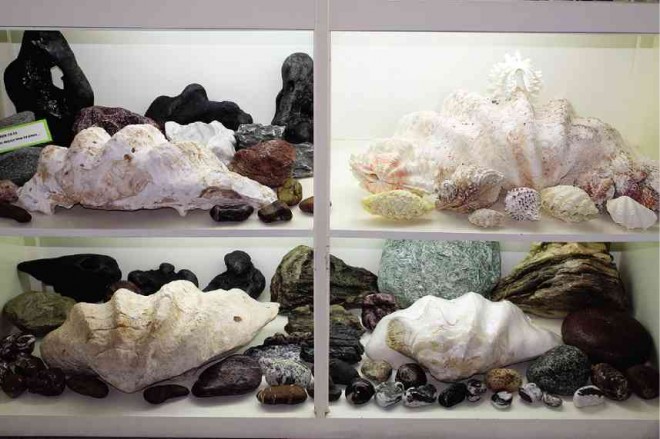The world is your oyster

FOSSIL specimens of “Tridacna gigas” on display at Marian School of Quezon City’s Museum of Rocks and Shells
Mollusks comprise the large phylum of invertebrate animals collectively known as Mollusca.
It is the largest marine phylum, accounting for 23 percent of all existing marine organisms. They live in freshwater, saltwater and terrestrial habitats.
Mollusca comprises six classes but the subject of this article will center on the class Bivalvia, all of whose members have two shells (“bi” means “two”). Univalves, such as the common garden snail, have only one shell.
Bivalves have soft, laterally compressed bodies enclosed by a shell consisting of two hinged parts.
This large family includes clams, oysters, mussels and scallops, all of them filter feeders and all of them extensively used as food by humans since the dawn of time.
Article continues after this advertisementThe giant clam Tridacna gigas, locally known as taklobo, is the largest living bivalve mollusk. It can weigh as much as 227 kilograms (500 pounds), grow to a length of 1.5 meters (5 feet) across and live in the wild for 100 years or more.
Article continues after this advertisementGiant clams live among coral sands and coral colonies and can be found at depths of up to 20 meters (66 feet). It is widely distributed throughout the Indo-Pacific oceans.
The giant clam was known in the past as a killer or man-eating clam. That urban legend has largely been debunked by findings that they are neither aggressive nor dangerous, mainly because their shells either close too slowly or are unable to close completely.
The pictures, taken at Marian School of Quezon City’s Museum of Rocks and Shells, show fossil specimens of Tridacna gigas that were excavated, together with other fossil specimens of univalves and corals, from the top of a mountain in the Cordilleras, located on the boundary of the provinces of La Union and Ilocos Sur, at the sources of the Amburayan River.
Heat and pressure from deep within the earth raise and fold the planet’s crust, thereby causing the seas to rise and fall. Limestone, a sedimentary rock that gradually formed in warm shallow seas from the accumulation of dead shellfish in over millions of years, was uplifted as converging continental plates rose to form mountains such as the Cordilleras.
This is the reason why pelagic mollusks may be found on land that is many miles removed from the sea.
Some say that the world is one’s oyster. But is it an oyster that gives you a pearl? Or a clam that clams up and refuses to give you the time of day?
Life is what we make it. We must aspire to emulate the oyster that writes its autobiography in the opalescent pages and layers of a pearl. We must strive to do good while we live and fastidiously create a pearl around the grit of a good name.
We must bequeath to the world the fossil of a good reputation.
The author is the academic supervisor at Marian School of Quezon City and curator of the school’s Museum of Rocks and Shells. E-mail him at [email protected].